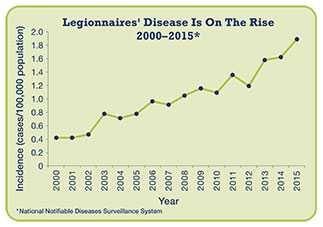Surveillance and Reporting
About 6,000 cases of Legionnaires’ disease were reported in the United States in 2015. However, because Legionnaires’ disease is likely underdiagnosed, this number may underestimate true incidence.
Trends
The number of cases reported to CDC has been on the rise since 2000. This could be due to a true increase in the frequency of disease due to a number of reasons (e.g., older U.S. population, more at-risk individuals, aging plumbing infrastructure) or increased testing for Legionnaires’ disease.
More illness usually occurs in the summer and early fall, but can happen any time of year.

In the United States, reported cases of Legionnaires’ disease have grown by nearly four and a half times since 2000.
It is unclear whether this increase represents artifact (due to increased awareness and testing), increased susceptibility of the population, increased Legionella in the environment, or some combination of factors.
Surveillance Systems and Reports
Legionellosis is a nationally notifiable disease that is monitored through two surveillance systems at the national level:
- Nationally Notifiable Diseases Surveillance System (NNDSS)
- Supplemental Legionnaires’ Disease Surveillance System (SLDSS)
The majority of reported cases are sporadic; however, clusters and outbreaks are commonly identified. Outbreaks of legionellosis are reported through the Waterborne Disease Outbreak Surveillance System (WBDOSS).
Cases of legionellosis should be reported to your local or state health department.
- Find your state health department.
- Submit case report form [1 page]
Call, fax, or mail this information to your local or state health department within 7 days of diagnosis.
How to Report Travel-associated Cases
Reporting travel-associated cases involves two steps:
- Email travellegionella@cdc.gov to let CDC know about travel-associated cases of Legionnaires’ disease within 7 days.
- Continue official notification mechanisms through NNDSS and through submission of case report forms [2 pages].
CDC will notify the state health departments where the patient traveled.
Case Definition
Guidance from the Council of State and Territorial Epidemiologists regarding surveillance for legionellosis includes case definitions. View the CSTE Position Statement
- Page last reviewed: June 1, 2017
- Page last updated: June 1, 2017
- Content source:


 ShareCompartir
ShareCompartir